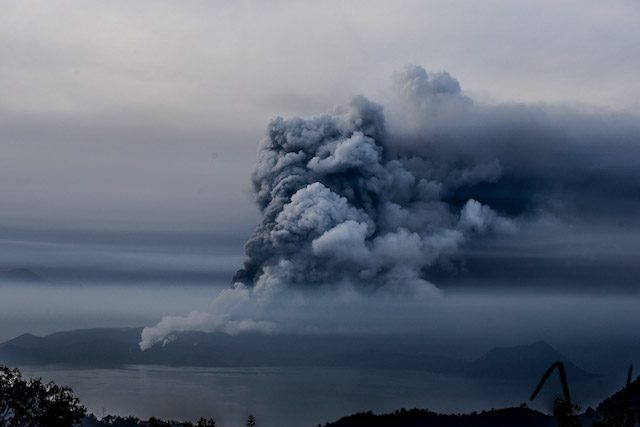SUMMARY
This is AI generated summarization, which may have errors. For context, always refer to the full article.

MANILA, Philippines (UPDATED) – After 42 years, Taal Volcano erupted again.
The last time it erupted was in October 1977, though several incidents of volcanic unrest were recorded in 2011, 2012, and 2014.
The January 2020 eruption has affected thousands of families and caused millions-worth of damage just days after the initial eruption on January 12.
Here’s what has happened so far.
January 12, Sunday
Taal Volcano started spewing ash Sunday afternoon, prompting the Philippine Institute of Volcanology and Seismology (Phivolcs) to raise its alert status to Level 2 at 2:30 pm. It was due to a “steam-driven” or phreatic eruption, according to Phivolcs, which happens when water beneath the ground or on the surface gets in contact with hot magma. (READ: FAST FACTS: Taal Volcano alert levels)
At 4 pm, Phivolcs raised the status again to Alert Level 3, indicating “magmatic unrest.” The ash column then had reached one-kilometer high.
Phivolcs raised the status to Alert Level 4 (hazardous eruption imminent) at 7:30 pm. The ash and rock fragments column reached up to 10-15 kilometers due to continuous eruption. There was also frequent volcanic lightning.
By Sunday night, ashfall from Taal Volcano had reached Calabarzon and Metro Manila. Several areas near Taal Volcano also experienced power outages due to ashfall, lava mud, and rocks.
January 13, Monday
Phivolcs observed lava fountains from Taal Volcano from 2:49 am to 4:28 am, but the alert status remained at Level 4. This was due to a magmatic eruption, which happens when gas within magma is decompressed and propels the magma forward.
At 3:20 am, ashfall was reported in the areas of Batangas, Tagaytay, Laguna, Cavite, Bulacan, Rizal, Muntinlupa, Las Piñas, Marikina, Parañaque, Pasig, Quezon City, Mandaluyong, San Juan, Manila, Makati City, and Taguig City.
Larger particles of rock fragments from the volcano were also reported in the areas of Tanauan and Talisay in Batangas, Nuvali and Sta Rosa in Laguna, and Tagaytay City.
The first confirmed casualty due to a road crash in Laguna was reported early Monday morning. Police said there was “zero visibility” at the time because of the ashfall.
In its 4 pm update, Phivolcs said “new lateral vents” opened up on the volcano’s northern side where short 500-meter lava fountains had been shooting out from. The agency further said a total of 144 volcanic earthquakes had been recorded in the Taal region since January 12, and warned that it may lead to “further eruptive activity.”
Batangas was placed under a state of calamity.
January 14, Tuesday
Phivolcs said surface activity of the Taal Volcano’s main crater slightly eased, and fewer emissions were seen from Taal Volcano as of 1 pm.
However, the agency also said there was still continuous magmatic activity and frequent volcanic earthquakes, which indicated that a “hazardous” eruption was still a possibility. The alert status remained at Level 4.
Batangas authorities approved a lockdown of Talisay, which meant nobody was allowed to enter the municipality to return to their homes until the area is declared out of danger.
In its 1 pm update, Phivolcs said lava fountains reached 800 meters high. New cracks on the ground were also spotted in the Batangas municipalities of Lemery, Agoncillo, Laurel, Talisay, and San Nicolas. A total of 335 volcanic earthquakes were recorded.
January 15, Wednesday
The volcano’s ongoing eruption generated dark gray columns of ash and hot magma, towering to an estimated 1,000 meters.
In its 5 pm update, Phivolcs said portions of Pansipit River had dried up. A total of 520 volcanic earthquakes had been recorded since January 12.
New cracks were also spotted on the ground in Batangas, particularly the areas of Sinisian, Mahabang Dahilig, Dayapan, Palanas, Sangalang, Poblacion, Mataas na Bayan, and Sambal Ibaba in Lemery; Pansipit and Bilibinwang in Agoncillo; and Poblacion 1, Poblacion 2, Poblacion 3, and Poblacion 5 in San Nicolas.
Authorities put the municipalities of Agoncillo, San Nicolas, Talisay, and Taal under complete lockdown, and imposed a partial lockdown on Lemery.
At least 3 Taal evacuees in Batangas died due to cardiac arrest.
Cavite, Batangas’ neighboring province, was placed under a state of calamity. The alert status remained at Level 4.
January 16, Thursday
Taal Volcano showed “weak” emission but “intense” tremors persisted as magma was still rising.
Phivolcs said a total of 9 “discrete weak explosions” were recorded from 9 am to 5 pm. The agency also said they were looking at the possibility of a lull for a considerable period of time.
The total number of earthquakes since January 12 rose to 595 as of 5 pm, but no additional cracks on the ground were reported. Alert status remained at Level 4.
January 17 to 25
Alert Level 4 stayed, as a hazardous eruption remained possible within hours to days.
But the Taal Volcano Network recorded a downtrend in volcanic earthquakes, from 944 to 420 events per day between January 17 and 24. There was also a decline in the daily total seismic energy released.
January 26, Sunday
Phivolcs downgraded Taal Volcano’s status to Alert Level 3, but said the unrest has not yet stopped and that people should remain cautious.
Phivolcs explained the reason for the downgrade was the “overall decrease in the level of monitoring parameters,” which included less frequent volcanic earthquakes, weaker steam or gas emissions at the main crater, and the slowdown of ground deformation.
Alert Level 3 means there is now a “decreased tendency towards hazardous eruption.” – Rappler.com
READ Rappler explainers on Taal Volcano:
Add a comment
How does this make you feel?
There are no comments yet. Add your comment to start the conversation.